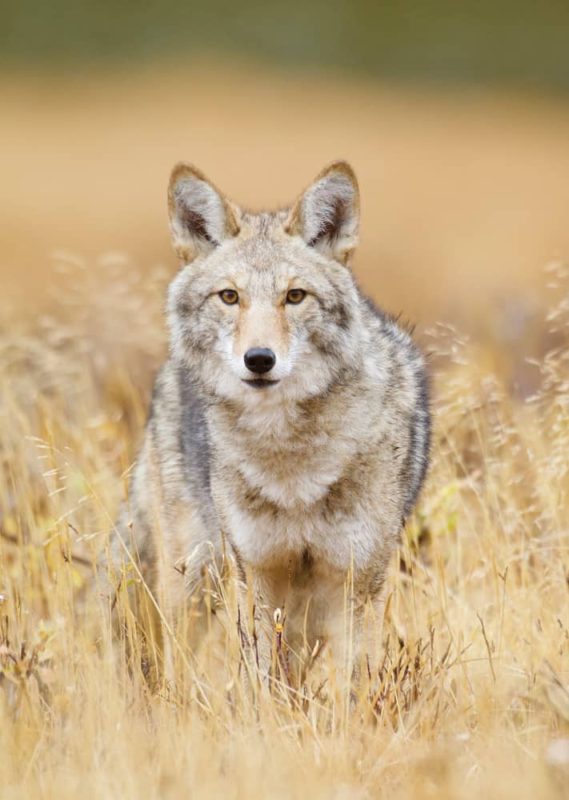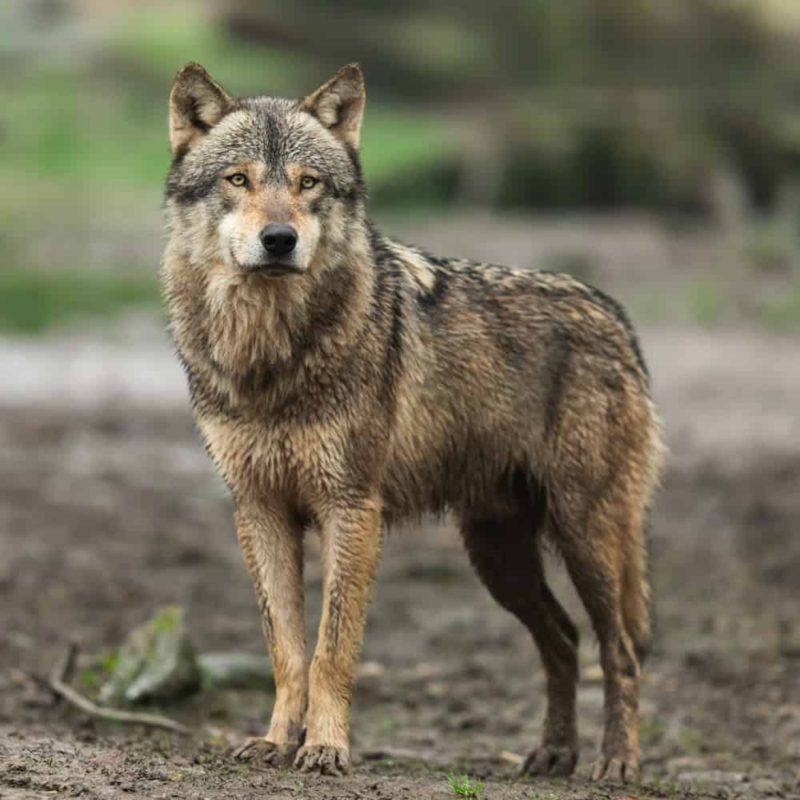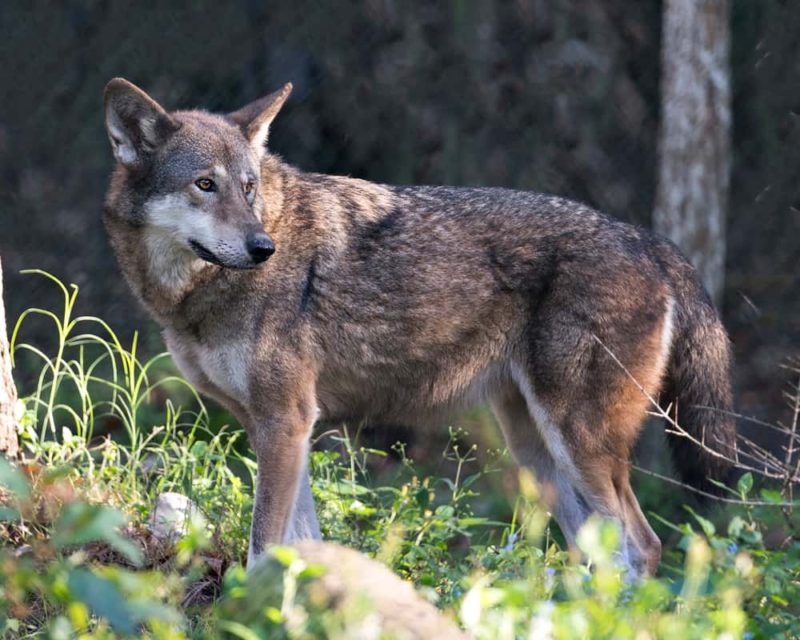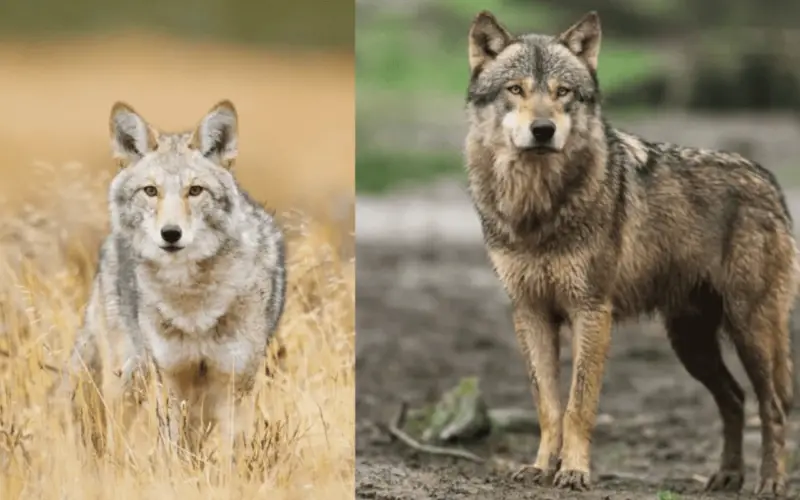Coyotes, wolves, and domestic dogs are all members of the Canidae family. It might be hard to decide what species of wild canid you’re looking at in areas where coyote habitat overlaps with wolf habitat. The most consistent way to tell the difference between a coyote and a wolf in size. However, using size alone as a means to differentiate between a coyote and a wolf isn’t always a foolproof method.
Primary Differences Between Wolves And Coyotes
- Size– There is a size difference between the two. Adult wolves are larger animals than adult coyotes.
- Body structure– Coyotes and wolves are constructed differently enough that if you know what to look for, it’s simple to differentiate between the two animals.
- Hair coat– Although coyotes and wolves have color phases that overlap one another, wolves come in more colors than coyotes do.

Wolf vs Coyote Size
In North America, we have gray wolves (Canis lupus), red wolves (Canis rufus), and the coyote (Canis latrans).
- Adult coyotes are smaller animals than adult wolves on average. Their size varies slightly across different sub species and geographic locations. However an average adult male coyote weighs 18 to 44 lbs (8 to 20 kg) while an average females weighs 15 to 40 lbs (7 to 18 kg). Southern coyotes are smaller than northern coyotes. Northern coyotes average around 18 kg while coyotes on the deserts of Mexico average around 11.5 kg. The largest coyote ever measured came from Wyoming. It weighed 74.82 pounds (33.94 kg) and measured 5.25 feet (1.6 meters) from the tip of it’s nose to the tip of it’s tail. Source
- Eastern coyotes which are a composite of coyotes, eastern wolves, and domestic dogs, “Canis familiaris“, are larger than western coyotes. In 2016, the UICN/SSC Canid Specialist Group proposed that the eastern coyote be a separate species with the scientific name “Canis oriens“, which is Latin for “eastern canid”. They also proposed that the eastern coyote be given the common name, “coywolf” due to its phenotypical and genetic distinctiveness. They weigh 45 to 55 lbs (20 to 25 kg) on average Source
- Red wolves are closer phenotypically to coyotes than gray wolves are. They weigh 50 to 85 lbs (23 to 39 kg)
- Gray wolves, with the exception of the Mexican gray wolf are much larger than the smaller canids we’ve been talking about. The Mexican gray wolf weighs 50 to 80 pounds. North American male gray wolves weighs from 70 to 130 pounds, stands 26 to 36 inches at the shoulders, and stretches five to six feet from nose to the tip of the tail. Females are about 20 percent smaller. The largest gray wolf ever recorded came from the Mackenzie valley of British Columbia It weighed 175 pounds. For comparison, a full grown male German Shepherd dog will stand up to 26 inches at the shoulder and weigh up to 88 pounds.

Coyote vs Wolf Body Structure
Apart from their larger size, wolves are put together differently than coyotes. Wolves have a wider face and large muscular heads. On the other hand, in comparison to the wolf, coyotes are proportionately narrower between the ears and have slender faces.
Compared to the size of their heads, coyotes have larger ears than gray wolves. On the other hand, gray wolves’ ears are probably comparably close to the size of coyote ears. They are proportionally, though, smaller compared to the size of their heads. One last observation on ears is that coyotes have triangular ears while gray wolves have rounded ears.
Red wolves have pointed ears compared to gray wolves. What’s more, their ears are proportionately larger than the ears of either coyotes or gray wolves.
The tails of these animals also differ. One of the main differences is that coyotes have bushier tails than wolves. Additionally, the tail of a coyote appears to be proportionately longer than a wolf’s tail does. One last thing on tails is that wolves tend to move with their tails held erect. On the other hand, coyotes are more prone to keep their tails down and close to their legs. So, when other identifying points aren’t quite enough to help you make an identification, you can say that animals that move with their long bushy tails in close to their legs are probably coyotes and not wolves.
In general body construction, wolves appear to be lean, long legged, and heavy boned. On the other hand, coyotes’ legs are shorter in proportion to the size of their bodies and finer boned compared to wolves. One other thing that makes coyote legs appear to be shorter is that the upper half of each of their legs is covered with long fur.
Connected to their legs are their feet. Wolves have large feet. Coyotes appear to have small, delicate feet in comparison to the big blocky feet that wolves have. An adult wolf track dwarfs the track of even the largest coyotes. The maximum size for coyote tracks is 2 3/4 inches long by about 2 inches wide. On the other hand, wolf tracks can be up to 5 inches long by 4 inches wide. Source

Coyote vs Wolf Hair Coat
According to the ODFW wolves website, only approximately 1/2 of any gray wolf population is actually gray. Gray wolves may be white, tawny gray or black, or any combination of those colors.
Red wolves are more similar in appearance to coyotes than gray wolves are. Their fur is gray, interspersed with red over most of their body.
The majority of the coyote population over North and Central America is tawny gray, interspersed with brown or black. This varies with the sub-species and geographic region. There are instances of melanistic or black coyotes in the southeastern U.S. Black coyotes and wolves have domestic dog DNA in their genetic background.
Where Do Wolves And Coyotes Live?
Gray Wolves
Although they live on some of the outskirts of agricultural ranching areas in the western United States, gray wolves are better adapted to areas that have minimal disruption from human beings. They prefer wilderness and semi wilderness areas. In the U.S, there are gray wolf populations in Alaska, northern Michigan, northern Wisconsin, western Montana, northern Idaho, northeast Oregon, the Yellowstone area of Wyoming, Arizona, and New Mexico. Canadian gray wolves live in the Northwest Territories, Yukon Territory, Nunavut, British Columbia, Alberta, Saskatchewan, Manitoba, Ontario, Quebec, Newfoundland, and Labrador.
There are four recognized gray wolf subspecies. The first is the Arctic Gray wolf. Arctic Gray wolves, which are actually white in color live in the arctic regions of North America or in other words above around 66 degrees north latitude.
The second gray wolf sub-species is the Northwestern or Rocky Mountain gray wolf. Northwestern gray wolves live in the western United States and Canada.
The third gray wolf sub-species is the Great Plains Gray wolf. Great plains gray wolves live in the western Great Lakes region of the United States and Canada. Lone wolves have been spotted in North Dakota and South Dakota, but wildlife biologists have determined that these animals were probably just passing through the areas they were spotted in and that no active wolf packs exist within the two states.
The fourth gray wolf sub-species is the Mexican Gray Wolf. The Mexican gray wolf once ranged in New Mexico, Texas, and Arizona. it also ranged in the Sierra Madre mountains of northern Mexico. They have been effectively expatriated from their former range. Between 1977 and 1980, 5 Mexican gray wolves were captured in the wild to start a captive breeding program. In 1998 Mexican gray wolves were released back into the wilds of New Mexico and Arizona. As of 2021, there were around 186 wild Mexican Gray wolves, and 350 of them were in captivity. Source
Coyotes
Coyotes are quite adaptable. They live in wilderness and semi wilderness, but they also live in suburban and urban environments. Coyotes live throughout North and Central America, from Panama in the south to northern Canada and the Alaskan north slope in the north.
Red Wolves
Red wolves are an endangered species. They are nearly extinct in the wild as of October of 2021; there were an estimated 15 to 17 red wolves in Beaufort, Dare, Hyde, Tyrrell, and Washington counties of North Carolina. The U.S Fish and Wildlife Service does have a robust red wolf breeding program. As of October of 2021, there were 241 captive red wolves housed in USFW facilities across the United States. Source
Also, see:
Do Coyotes Hibernate? – Krebs Creek
All About Coyotes – Krebs Creek
Are Coyotes Dangerous? – Krebs Creek
Recent Posts
The only venomous snakes in Washington State are Northern Pacific Rattlesnakes. The Northern Pacific Rattlesnake (Crotalus oreganus oreganus) is a sub-species of the Western Rattlesnake. Anyone...
Skunks are not classified as true hibernators. But they go into a state of torpor when the weather gets cold. Skunks are light sleep hibernators, along with opossums, bears, and raccoons. ...

